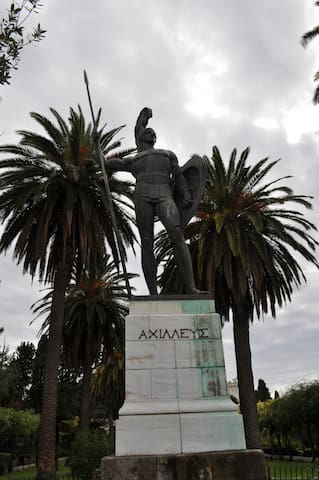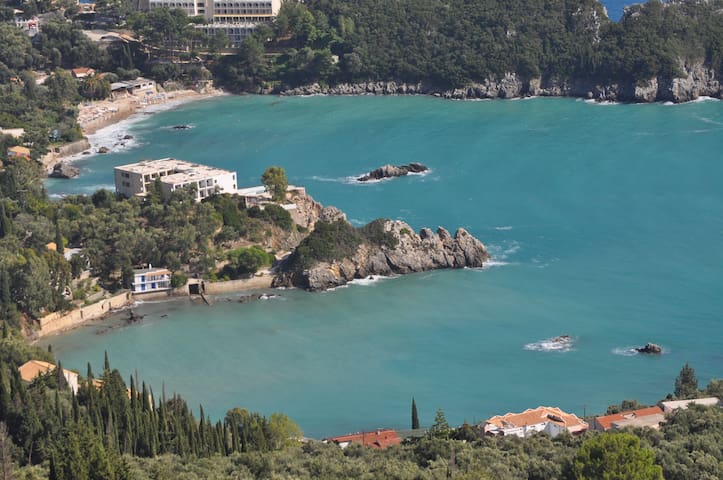Αξιοθέατα
In 1876, Elizabeth travelled on her own to Athens and Corfu and threw herself into a study of ancient Greek literature especially of Homer. She also took a keen interest in the excavations being carried out at the time by Heinrich Schliemann in Troy, Mycenae and Tiryns. After a long trip to Troy and many other parts of the ancient Greek world, she returned to Corfu in 1888 and stayed as a guest in the Vrailas villa. A year later, Elizabeth bought the estate and began work on the construction of the palace - in an atmosphere of profound mourning, because in the meantime her son Rudolf and his lover had been found dead. During her time at the Achilleio, Elizabeth learned the Greek language and much about the ancient literature from eminent teachers, notable among whom was the scholar and writer Constantinos Christomanos, who was officially employed for this purpose by the Imperial court. In 1898, the 'melancholy queen', as Elizabeth had come to be called, was assassinated in a hotel in Geneva by an Italian anarchist
Elizabeth called her palace at Gastouri the Achilleio, dedicating it to her favourite hero, Achilles; as she herself wrote, "here presents the Greek spirit, the beauty of the land", and is "as strong, as proud and as obstinate as a Greek mountain". The Achilleio was constructed in 1889-1891, by the Italian architects Rafael Corito and Antonio Lanti, under the personal supervision of the Empress, who also took charge of the ornamentation of the palace with paintings and sculptures, most of which were purchased from the Borghese family. It is a luxurious three storey building in the 'Pompeian order', with neo-Classical elements, and it is surrounded by densely-vegetated gardens adorned with important works of art. In 1908, after the death of Elizabeth, the Achilleio was bought by Wilhelm II, the German Kaiser, and in 1914 - on the outbreak of the First World War it was abandoned. In 1915, it was used as the headquarters of the Serbian Army and as a hospital, coming into the hands of the Greek state in 1919. During the Second World War it served as a hospital again - and as the headquarters of the German and Italian occupying forces - and after liberation it houses a variety of schools and institutions. Today, it belongs to the National Tourist Organisation and from 1962 to 1992 Corfu casino operated there. The ground floor of the building functions as a museum.
332 personas locales recomiendan
Achilleion
In 1876, Elizabeth travelled on her own to Athens and Corfu and threw herself into a study of ancient Greek literature especially of Homer. She also took a keen interest in the excavations being carried out at the time by Heinrich Schliemann in Troy, Mycenae and Tiryns. After a long trip to Troy and many other parts of the ancient Greek world, she returned to Corfu in 1888 and stayed as a guest in the Vrailas villa. A year later, Elizabeth bought the estate and began work on the construction of the palace - in an atmosphere of profound mourning, because in the meantime her son Rudolf and his lover had been found dead. During her time at the Achilleio, Elizabeth learned the Greek language and much about the ancient literature from eminent teachers, notable among whom was the scholar and writer Constantinos Christomanos, who was officially employed for this purpose by the Imperial court. In 1898, the 'melancholy queen', as Elizabeth had come to be called, was assassinated in a hotel in Geneva by an Italian anarchist
Elizabeth called her palace at Gastouri the Achilleio, dedicating it to her favourite hero, Achilles; as she herself wrote, "here presents the Greek spirit, the beauty of the land", and is "as strong, as proud and as obstinate as a Greek mountain". The Achilleio was constructed in 1889-1891, by the Italian architects Rafael Corito and Antonio Lanti, under the personal supervision of the Empress, who also took charge of the ornamentation of the palace with paintings and sculptures, most of which were purchased from the Borghese family. It is a luxurious three storey building in the 'Pompeian order', with neo-Classical elements, and it is surrounded by densely-vegetated gardens adorned with important works of art. In 1908, after the death of Elizabeth, the Achilleio was bought by Wilhelm II, the German Kaiser, and in 1914 - on the outbreak of the First World War it was abandoned. In 1915, it was used as the headquarters of the Serbian Army and as a hospital, coming into the hands of the Greek state in 1919. During the Second World War it served as a hospital again - and as the headquarters of the German and Italian occupying forces - and after liberation it houses a variety of schools and institutions. Today, it belongs to the National Tourist Organisation and from 1962 to 1992 Corfu casino operated there. The ground floor of the building functions as a museum.
Palaiokastritsa is one of the most picturesque and busiest places on Corfu, and has been a famous resort area since the period of British rule. The village is spread around six little bays (Ambelaki, Agios (Ayios) Petros, Agios (Ayios) Spyridon, Alipa, Platakia, Ayia Triada) all of which have sandy beaches and caves and are backed by verdant hills covered with olive trees. The beaches of Palaiokastritsa are very popular with bathers, who when not engaging in the sea sports available there can try fresh lobster - for which the area is famous - at one of the numerous little taverns. Caiques sail from these bays to a number of other nearby coves which are not accessible by land.
In the sea are the islets of Skeloudi and Kolovri; a story connected with Kolovri tells us that it was the ship of some Algerian pirates which was turned to stone by divine intervention to prevent the pirates from attacking the monastery of Palaiokastritsa. Some archaeologists believe that the city of the Phaeacians and the palace of Alcinous were actually somewhere near Palaiokastritsa. Their views are not, however, generally accepted. According to these scholars, the acropolis of Scheria would have been on the hill now occupied by the monastery of Our Lady the Mother of God. The monastery was founded in 1228, but the buildings we see today date from no earlier than the eighteenth and nineteenth centuries. The arched courtyard is very beautiful, as is the view out over the bays of Palaiokastritsa. The monastery church was built in 1722 and is a single-aisled basilica. It has an interesting collection of icons dating from the fifteenth to the eighteenth century. More notable Byzantine and post-Byzantine icons, together with vestments, sacred books and holy vessels, are housed in the little monastery museum. Not far from Palaiokastritsa (4 km) is the village of Lakones, where the spot called Bella Vista has a panoramic view of the deeply indented coast around Palaiokastritsa. The road continues to the village of Krini, from which a path leads in 3 km. to the superb fortress of Angelokastro.
Angelokastro, one of the few Byzantine castles of Corfu, was built in the thirteenth century by Michael I Angelus Ducas, ruler of the Despotate of Epirus, to protect Corfu against the incursions of pirates. Not much has survived of the buildings inside the castle, but the climb up to the top of the precipitous hill on which it stands is worth the effort for the incredible view out to sea and east towards Corfu town. The road between Palaiokastritsa and Corfu town - a smooth run of some 25 km. - was built by the British in 1828 to improve their control over the area.
263 personas locales recomiendan
Palaiokastritsa
Palaiokastritsa is one of the most picturesque and busiest places on Corfu, and has been a famous resort area since the period of British rule. The village is spread around six little bays (Ambelaki, Agios (Ayios) Petros, Agios (Ayios) Spyridon, Alipa, Platakia, Ayia Triada) all of which have sandy beaches and caves and are backed by verdant hills covered with olive trees. The beaches of Palaiokastritsa are very popular with bathers, who when not engaging in the sea sports available there can try fresh lobster - for which the area is famous - at one of the numerous little taverns. Caiques sail from these bays to a number of other nearby coves which are not accessible by land.
In the sea are the islets of Skeloudi and Kolovri; a story connected with Kolovri tells us that it was the ship of some Algerian pirates which was turned to stone by divine intervention to prevent the pirates from attacking the monastery of Palaiokastritsa. Some archaeologists believe that the city of the Phaeacians and the palace of Alcinous were actually somewhere near Palaiokastritsa. Their views are not, however, generally accepted. According to these scholars, the acropolis of Scheria would have been on the hill now occupied by the monastery of Our Lady the Mother of God. The monastery was founded in 1228, but the buildings we see today date from no earlier than the eighteenth and nineteenth centuries. The arched courtyard is very beautiful, as is the view out over the bays of Palaiokastritsa. The monastery church was built in 1722 and is a single-aisled basilica. It has an interesting collection of icons dating from the fifteenth to the eighteenth century. More notable Byzantine and post-Byzantine icons, together with vestments, sacred books and holy vessels, are housed in the little monastery museum. Not far from Palaiokastritsa (4 km) is the village of Lakones, where the spot called Bella Vista has a panoramic view of the deeply indented coast around Palaiokastritsa. The road continues to the village of Krini, from which a path leads in 3 km. to the superb fortress of Angelokastro.
Angelokastro, one of the few Byzantine castles of Corfu, was built in the thirteenth century by Michael I Angelus Ducas, ruler of the Despotate of Epirus, to protect Corfu against the incursions of pirates. Not much has survived of the buildings inside the castle, but the climb up to the top of the precipitous hill on which it stands is worth the effort for the incredible view out to sea and east towards Corfu town. The road between Palaiokastritsa and Corfu town - a smooth run of some 25 km. - was built by the British in 1828 to improve their control over the area.


